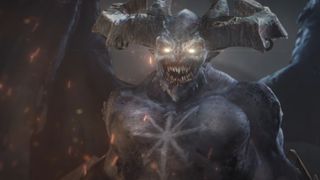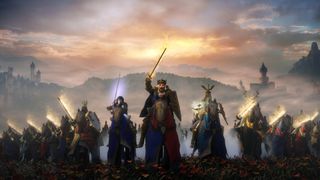Creative Assembly is revealing the numbers behind Total War: Warhammer 3, praise to Mathal, Chaos God of algebra
Stats for the stats throne.

There are a lot of things we do in Total War because they seem like common sense, even though we don't know if the systems behind the scenes really back them up. I put my archers on hills because I think I remember a loading screen tip saying that raised elevation increases your damage output, but by how much? And does it apply equally to melee attacks?
Fortunately, Creative Assembly recently began explaining what goes on under the hood of Total War: Warhammer 3 in a series of blog posts called the Feature Focus series, which are doing a great job translating those assumptions into actual numbers, even if they slip into algebra at times, like saying "coefficient" when they could just say "multiplier".
Elevation was the topic of the first post in the series, which clarified that the damage multiplier based on height difference is calculated from the base of each model. That means, as CA put it, "being tall does not actually factor into elevation modifiers". Turns out my ogre chieftain, Large Marge, does not actually get additional bonus damage when hitting goblins who are five feet shorter.
For ranged damage the maximum bonus to damage is 30%, which requires a height difference of 40 meters. There's also a damage penalty for shooting upwards, with the same 40-meter difference resulting in an equivalent maximum damage penalty of 30%. "Flying units hover roughly 16 meters above the ground," the post continued, "and so they benefit from an elevation damage bonus of 12% if their target is standing on ground level." That bonus can be increased by situating flying units over tall terrain to increase the difference between their hover height and flat ground. And yes, elevation does factor into melee damage calculations, though in melee the maximum difference in elevation multiplier is one meter.
The elevation post also clarified that we were right in assuming units would go faster downhill and get fatigued faster going uphill, though it notes that "no fatigue benefit is gained by going downhill." Oh, and also units that have the "Strider" attribute ignore basically all terrain penalties, including the one about shooting up.
The latest post in the series is all about damage. It details how armor and armor-piercing damage work, as well as resistances. Now we know that when units are on fire, healing them is half as effective as normal. Maybe wait for them to stop, drop, and roll before you rush in to patch them up after the dwarfs with irondrake flamethrowers do their thing. Another important clarification: magical attacks don't ignore armor, which is good news for the Bretonnians, who go into battle wearing more protective gear than American footballers.

There are apparently enough different ways you can hurt people in Total War: Warhammer 3 that damage needs a second article to deal with the rest of them. The next in the series will be "looking at the specific quirks of Explosions, Vortexes and Wind effects, cracking the case of how damage is applied by Large Monsters and Lords using splash attacks, and opening the forbidden box labelled 'Game Ticks.'" Don't threaten me with a good time, Creative Assembly. "Also on the way are deep dives into projectiles and target penetration. Plus, we'll be parallel parking our way into the topic of chariots, mass and charges."
The biggest gaming news, reviews and hardware deals
Keep up to date with the most important stories and the best deals, as picked by the PC Gamer team.
That's something to look forward to, and will maybe help me figure out why my Vampire Counts army never got much value out of the Black Coach—an expensive single-entity chariot that tended to underperform compared to other units, like some of the local dogs I rounded up and put spikes on.

Jody's first computer was a Commodore 64, so he remembers having to use a code wheel to play Pool of Radiance. A former music journalist who interviewed everyone from Giorgio Moroder to Trent Reznor, Jody also co-hosted Australia's first radio show about videogames, Zed Games. He's written for Rock Paper Shotgun, The Big Issue, GamesRadar, Zam, Glixel, Five Out of Ten Magazine, and Playboy.com, whose cheques with the bunny logo made for fun conversations at the bank. Jody's first article for PC Gamer was about the audio of Alien Isolation, published in 2015, and since then he's written about why Silent Hill belongs on PC, why Recettear: An Item Shop's Tale is the best fantasy shopkeeper tycoon game, and how weird Lost Ark can get. Jody edited PC Gamer Indie from 2017 to 2018, and he eventually lived up to his promise to play every Warhammer videogame.
Most Popular






